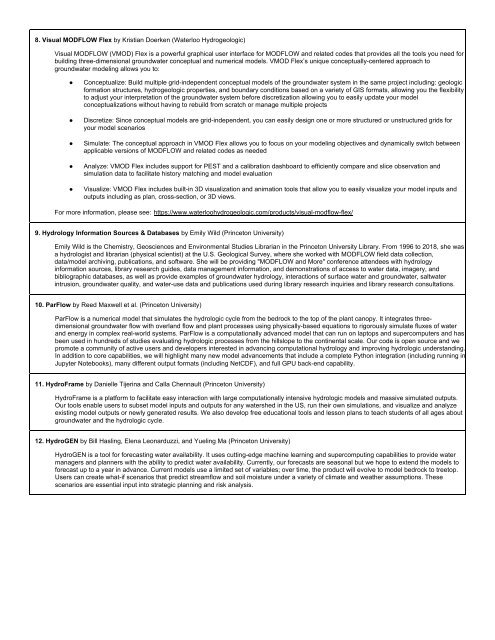MODFLOW and More 2022 Program
Create successful ePaper yourself
Turn your PDF publications into a flip-book with our unique Google optimized e-Paper software.
8. Visual <strong>MODFLOW</strong> Flex by Kristian Doerken (Waterloo Hydrogeologic)<br />
Visual <strong>MODFLOW</strong> (VMOD) Flex is a powerful graphical user interface for <strong>MODFLOW</strong> <strong>and</strong> related codes that provides all the tools you need for<br />
building three-dimensional groundwater conceptual <strong>and</strong> numerical models. VMOD Flex’s unique conceptually-centered approach to<br />
groundwater modeling allows you to:<br />
●<br />
●<br />
●<br />
●<br />
●<br />
Conceptualize: Build multiple grid-independent conceptual models of the groundwater system in the same project including: geologic<br />
formation structures, hydrogeologic properties, <strong>and</strong> boundary conditions based on a variety of GIS formats, allowing you the flexibility<br />
to adjust your interpretation of the groundwater system before discretization allowing you to easily update your model<br />
conceptualizations without having to rebuild from scratch or manage multiple projects<br />
Discretize: Since conceptual models are grid-independent, you can easily design one or more structured or unstructured grids for<br />
your model scenarios<br />
Simulate: The conceptual approach in VMOD Flex allows you to focus on your modeling objectives <strong>and</strong> dynamically switch between<br />
applicable versions of <strong>MODFLOW</strong> <strong>and</strong> related codes as needed<br />
Analyze: VMOD Flex includes support for PEST <strong>and</strong> a calibration dashboard to efficiently compare <strong>and</strong> slice observation <strong>and</strong><br />
simulation data to facilitate history matching <strong>and</strong> model evaluation<br />
Visualize: VMOD Flex includes built-in 3D visualization <strong>and</strong> animation tools that allow you to easily visualize your model inputs <strong>and</strong><br />
outputs including as plan, cross-section, or 3D views.<br />
For more information, please see: https://www.waterloohydrogeologic.com/products/visual-modflow-flex/<br />
9. Hydrology Information Sources & Databases by Emily Wild (Princeton University)<br />
Emily Wild is the Chemistry, Geosciences <strong>and</strong> Environmental Studies Librarian in the Princeton University Library. From 1996 to 2018, she was<br />
a hydrologist <strong>and</strong> librarian (physical scientist) at the U.S. Geological Survey, where she worked with <strong>MODFLOW</strong> field data collection,<br />
data/model archiving, publications, <strong>and</strong> software. She will be providing "<strong>MODFLOW</strong> <strong>and</strong> <strong>More</strong>" conference attendees with hydrology<br />
information sources, library research guides, data management information, <strong>and</strong> demonstrations of access to water data, imagery, <strong>and</strong><br />
bibliographic databases, as well as provide examples of groundwater hydrology, interactions of surface water <strong>and</strong> groundwater, saltwater<br />
intrusion, groundwater quality, <strong>and</strong> water-use data <strong>and</strong> publications used during library research inquiries <strong>and</strong> library research consultations.<br />
10. ParFlow by Reed Maxwell et al. (Princeton University)<br />
ParFlow is a numerical model that simulates the hydrologic cycle from the bedrock to the top of the plant canopy. It integrates threedimensional<br />
groundwater flow with overl<strong>and</strong> flow <strong>and</strong> plant processes using physically-based equations to rigorously simulate fluxes of water<br />
<strong>and</strong> energy in complex real-world systems. ParFlow is a computationally advanced model that can run on laptops <strong>and</strong> supercomputers <strong>and</strong> has<br />
been used in hundreds of studies evaluating hydrologic processes from the hillslope to the continental scale. Our code is open source <strong>and</strong> we<br />
promote a community of active users <strong>and</strong> developers interested in advancing computational hydrology <strong>and</strong> improving hydrologic underst<strong>and</strong>ing.<br />
In addition to core capabilities, we will highlight many new model advancements that include a complete Python integration (including running in<br />
Jupyter Notebooks), many different output formats (including NetCDF), <strong>and</strong> full GPU back-end capability.<br />
11. HydroFrame by Danielle Tijerina <strong>and</strong> Calla Chennault (Princeton University)<br />
HydroFrame is a platform to facilitate easy interaction with large computationally intensive hydrologic models <strong>and</strong> massive simulated outputs.<br />
Our tools enable users to subset model inputs <strong>and</strong> outputs for any watershed in the US, run their own simulations, <strong>and</strong> visualize <strong>and</strong> analyze<br />
existing model outputs or newly generated results. We also develop free educational tools <strong>and</strong> lesson plans to teach students of all ages about<br />
groundwater <strong>and</strong> the hydrologic cycle.<br />
12. HydroGEN by Bill Hasling, Elena Leonarduzzi, <strong>and</strong> Yueling Ma (Princeton University)<br />
HydroGEN is a tool for forecasting water availability. It uses cutting-edge machine learning <strong>and</strong> supercomputing capabilities to provide water<br />
managers <strong>and</strong> planners with the ability to predict water availability. Currently, our forecasts are seasonal but we hope to extend the models to<br />
forecast up to a year in advance. Current models use a limited set of variables; over time, the product will evolve to model bedrock to treetop.<br />
Users can create what-if scenarios that predict streamflow <strong>and</strong> soil moisture under a variety of climate <strong>and</strong> weather assumptions. These<br />
scenarios are essential input into strategic planning <strong>and</strong> risk analysis.
















